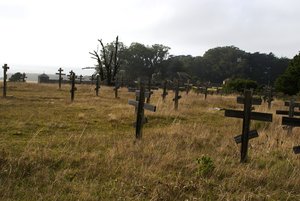Advertisement
Published: December 19th 2012

 FORT ROSS
FORT ROSS
Fort Ross is on Hwy 1 a few miles north of Jenner. It is a narrow winding road and you might need some dramimine if you are prone to car sickness. FORT ROSS
On a clear day you can see Mt Shasta from Fort Ross. Shasta is not an English word, it is not an Indian Word, nor is it a Spanish word. It is a Russian word meaning “shimmering mountain over yonder in the distance thataway”. The Russians, the English, and the Spanish, all had plans for territorial expansion in western North America. The local Indians simply hoped to keep what they already had. “Ross” is poetic term meaning Russia to people who speak that language. The first Russians that came to California arrived in 1803 aboard American ships. They were part of a joint fur venture with American ship captains. When those Russians got back to Sitka they told their boss, Alexander Baranov, that there was plenty of unoccupied land north of the Spanish possessions that seemed to end at San Francisco. Baranov sent the information up his chain of command and in 1806 the Russian Ambassador to Japan and Director of the Russian America Company, NP Rezanov, came to San Francisco to organize a formal trade agreement with the Spanish authorities. Rezanov tried to do things right, but he was dealing with Mexicans which must have been an exasperating experience. The recommendation he made to both Baranov in Sitka, and to Emperor Aleksandr I back home on the other side of the world was that settlement ought to be attempted north of San Francisco. It would not be likely to face opposition from local authorities. The place they liked best for their settlement was Bodega Bay but they dawdled around too long. By 1812 when they showed up to plant the flag and start building Bodega Bay was occupied by American ships. They had to settle on a site a few miles to the north that had minimal anchorage. They built a church, a fort, a few homes and storage sheds, and put in some farms and before long they had a thriving community full of European innovations. The first all wood structures in California that had stoves and window glass were built at Fort Ross. The first windmills were put into service at Fort Ross. The first disease control measures in California were implemented by Russians. They supplied vaccines to Monterey for an outbreak there, and prevented a group from the Hudson Bay Company that had spread a massive epidemic of smallpox through the Central Valley from passing through Fort Ross. The farms at Fort Ross, supplemented with a little judicious trading with the Spanish missions, were able to supply the agricultural needs of the fur outposts in Alaska. Food for the Alaska fur outposts was the whole reason for the existence of Fort Ross. The Russians had done many good things in California but in 1838 the missions were secularized and trade stopped with them. By 1841 a trade agreement with the Hudson Bay Company at Fort Vancouver went into effect and Fort Ross was sold to John Sutter. Sutter was rich in land holdings and big ideas, but he seldom had much cash on hand. He took possession of Fort Ross without ever having paid what he owed for the property. In 1849 Sutter signed over some notes on the property to the Russian America Company, but they were worthless no doubt. Maybe somebody ought to look into that transaction. The Russians might still own it and could probably run things in that area better than we have. The photo shows the cemetery at For Ross.
Advertisement
Tot: 0.201s; Tpl: 0.012s; cc: 11; qc: 52; dbt: 0.1036s; 1; m:domysql w:travelblog (10.17.0.13); sld: 1;
; mem: 1.1mb

 FORT ROSS
FORT ROSS